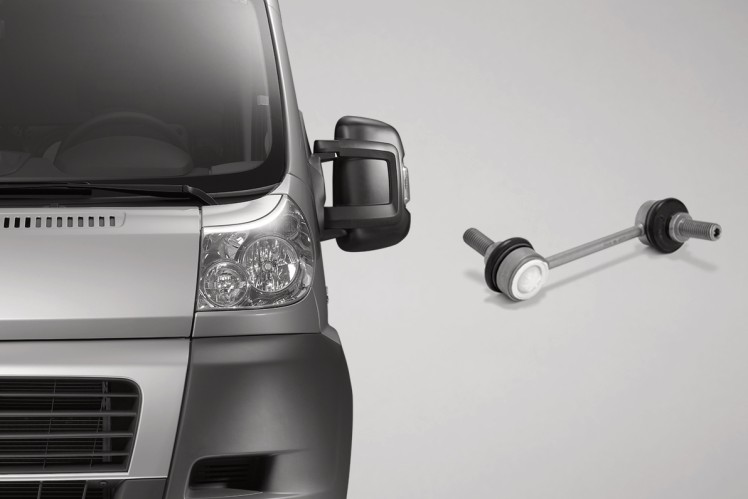ZF Aftermarket supplies chassis parts for numerous LCV models - Growth and age of LCV fleet drives market for repair work
- Usage profile subjects the chassis to heavy loads
- Under its Lemförder brand, ZF Aftermarket offers the right spare parts
High mileage, heavy loads, constant use – the light commercial vehicle is the automotive workhorse. With this class of vehicle subjected to considerable pressure and stress, together with the average age of LCVs in the EU being 10.9 years (i), this segment of the vehicle parc offers significant service and repair opportunities for workshops. ZF Aftermarket helps workshops position themselves in this segment and here, under its Lemförder brand, the business offers repair tips for one of its most popular vehicles, the Volkswagen T5. Around 2.6 million LCVs (up to 3.5 tons gross vehicle weight) are registered in Germany.

33.2 million LCVs (up to 3.5 tons gross vehicle weight) are in circulation throughout the European Union. Counting more than 6.2 million vehicles, France has by far the largest van fleet, followed by Spain (4.6 million), the United Kingdom (4.4 million vans) and Italy (4.2 million).
These vehicles are often used daily to carry high payloads meaning they are also subject to high wear. Failure rates for LCV vehicle safety inspections are higher in all age categories than for passenger cars, reflecting this increased wear. For example, the failure rate for LCVs over ten years old is 30 percent.
Many businesses utilize their vehicles' full permissible payload in daily usage. While the chassis itself may be designed for this kind of usage, compression ball and tie rod joints, stabilizer links and other steering and chassis parts suffer considerably under permanent load. ZF Aftermarket therefore recommends workshops to visually inspect the chassis, test it for height clearance each time an LCV comes into the auto repair shop; replacing damaged and worn components as applicable. This is the only way of guaranteeing safe vehicle handling and ensuring the vehicle passes the next vehicle safety inspection as test centers have hydraulic joint play detectors that ruthlessly pinpoint faults within the chassis system.
Repair tips from ZF Aftermarket for the Volkswagen T5
The Volkswagen T5 LCV model range is one of the most popular vehicles in the segment under 3.5 tons. Under its Lemförder brand, ZF Aftermarket supplies a comprehensive range of chassis parts, including control arms, stabilizer links and rubber-bonded metal mounts.
Wear damage on the suspension-strut mount often occurs on this vehicle due to the undersized ball bearing in the initial design. Volkswagen subsequently replaced the component with a version with a larger bearing, although both versions can still be found in the market. ZF Aftermarket offers both variants but advises customers to upgrade to the new version where the initial version is still fitted. When removing the affected parts, the technician must always note which of the two variants is fitted to the vehicle. A damaged spring plate on the earlier bearing variant means having to replace the entire assembly as new spring plates are no longer available. The auto repair shop must therefore install a new suspension-strut mount, the spring plate and the ball bearing. ZF Aftermarket also recommends always replacing these parts per axle to ensure consistent vehicle handling on both sides.
Certain points need to be considered when replacing the T5 control arm. After removing the old part, the mechatronics technician should clean the supporting surface of the ball stud on the steering knuckle using sandpaper, followed by a suitable cleaning agent. Otherwise, rust and dirt particles may penetrate the joint of the new control arm via the ball stud, resulting in rapid wear.
The workshop employee must not tighten the mounting bolts and nuts with the suspension still in the fully unloaded state. Otherwise the rubber bearings would be deformed when lowering the vehicle onto the wheels. This undesirable preloading of the bearings may lead to premature wear. The next work step is to lower the vehicle until the chassis is fully compressed. There may, however, be regulations governing the position in which the bolts and nuts are tightened depending on the vehicle model – so note the VMs installation instructions. All chassis data specified by the vehicle manufacturer relates to the design position.
A wheel-free four-post car lift can be useful here. It allows the bolts and nuts to be tightened to the torque specified by the manufacturer. Finally, the auto repair shop must check and set the wheel alignment according to the manufacturer's specifications.
Many new items in the Lemförder chassis range
ZF Aftermarket is continually expanding its chassis range for LCVs. New additions to the portfolio include:
- Axle boot and steering system for the Ford Transit/Tourneo Custom
- Inner tie rod, tie rod and tie-rod end for Citroën Jumpy/Peugeot Expert/Toyota Proace
- Rear-axle mount and stabilizer mount for VW T5/T6 and Crafter
- Front-axle mount and control arm for VW Crafter
- Front-axle control arm and steering knuckle for Renault Kangoo and Mercedes Citan
(i) https://www.acea.be/uploads/publications/ACEA_Report_Vehicles_in_use-E
- Growth and age of LCV fleet drives market for repair work
- Usage profile subjects the chassis to heavy loads
- Under its Lemförder brand, ZF Aftermarket offers the right spare parts
High mileage, heavy loads, constant use – the light commercial vehicle is the automotive workhorse. With this class of vehicle subjected to considerable pressure and stress, together with the average age of LCVs in the EU being 10.9 years (i), this segment of the vehicle parc offers significant service and repair opportunities for workshops. ZF Aftermarket helps workshops position themselves in this segment and here, under its Lemförder brand, the business offers repair tips for one of its most popular vehicles, the Volkswagen T5. Around 2.6 million LCVs (up to 3.5 tons gross vehicle weight) are registered in Germany.

33.2 million LCVs (up to 3.5 tons gross vehicle weight) are in circulation throughout the European Union. Counting more than 6.2 million vehicles, France has by far the largest van fleet, followed by Spain (4.6 million), the United Kingdom (4.4 million vans) and Italy (4.2 million).
These vehicles are often used daily to carry high payloads meaning they are also subject to high wear. Failure rates for LCV vehicle safety inspections are higher in all age categories than for passenger cars, reflecting this increased wear. For example, the failure rate for LCVs over ten years old is 30 percent.
Many businesses utilize their vehicles' full permissible payload in daily usage. While the chassis itself may be designed for this kind of usage, compression ball and tie rod joints, stabilizer links and other steering and chassis parts suffer considerably under permanent load. ZF Aftermarket therefore recommends workshops to visually inspect the chassis, test it for height clearance each time an LCV comes into the auto repair shop; replacing damaged and worn components as applicable. This is the only way of guaranteeing safe vehicle handling and ensuring the vehicle passes the next vehicle safety inspection as test centers have hydraulic joint play detectors that ruthlessly pinpoint faults within the chassis system.
Repair tips from ZF Aftermarket for the Volkswagen T5
The Volkswagen T5 LCV model range is one of the most popular vehicles in the segment under 3.5 tons. Under its Lemförder brand, ZF Aftermarket supplies a comprehensive range of chassis parts, including control arms, stabilizer links and rubber-bonded metal mounts.
Wear damage on the suspension-strut mount often occurs on this vehicle due to the undersized ball bearing in the initial design. Volkswagen subsequently replaced the component with a version with a larger bearing, although both versions can still be found in the market. ZF Aftermarket offers both variants but advises customers to upgrade to the new version where the initial version is still fitted. When removing the affected parts, the technician must always note which of the two variants is fitted to the vehicle. A damaged spring plate on the earlier bearing variant means having to replace the entire assembly as new spring plates are no longer available. The auto repair shop must therefore install a new suspension-strut mount, the spring plate and the ball bearing. ZF Aftermarket also recommends always replacing these parts per axle to ensure consistent vehicle handling on both sides.
Certain points need to be considered when replacing the T5 control arm. After removing the old part, the mechatronics technician should clean the supporting surface of the ball stud on the steering knuckle using sandpaper, followed by a suitable cleaning agent. Otherwise, rust and dirt particles may penetrate the joint of the new control arm via the ball stud, resulting in rapid wear.
The workshop employee must not tighten the mounting bolts and nuts with the suspension still in the fully unloaded state. Otherwise the rubber bearings would be deformed when lowering the vehicle onto the wheels. This undesirable preloading of the bearings may lead to premature wear. The next work step is to lower the vehicle until the chassis is fully compressed. There may, however, be regulations governing the position in which the bolts and nuts are tightened depending on the vehicle model – so note the VMs installation instructions. All chassis data specified by the vehicle manufacturer relates to the design position.
A wheel-free four-post car lift can be useful here. It allows the bolts and nuts to be tightened to the torque specified by the manufacturer. Finally, the auto repair shop must check and set the wheel alignment according to the manufacturer's specifications.
Many new items in the Lemförder chassis range
ZF Aftermarket is continually expanding its chassis range for LCVs. New additions to the portfolio include:
- Axle boot and steering system for the Ford Transit/Tourneo Custom
- Inner tie rod, tie rod and tie-rod end for Citroën Jumpy/Peugeot Expert/Toyota Proace
- Rear-axle mount and stabilizer mount for VW T5/T6 and Crafter
- Front-axle mount and control arm for VW Crafter
- Front-axle control arm and steering knuckle for Renault Kangoo and Mercedes Citan
(i) https://www.acea.be/uploads/publications/ACEA_Report_Vehicles_in_use-E
MEDIA
CONTACT

